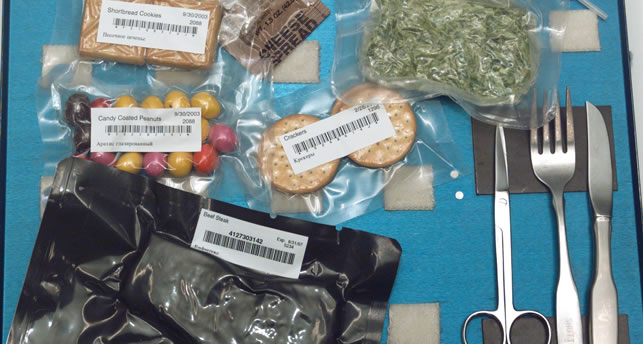Technology: Colin Moors looks into the progress of technology that is close to his heart… and his stomach – high tech food.
“Ground control to Major Tom, take your protein pills and put your helmet on…”
When Bowie wrote the lyric, we had already seen a man in space and any science
geek worth their salt would have known about the dehydrated ice cream they took
with them. Of course, the food magazines went crazy conjecturing about the possibility that we’d all be eating a pill for breakfast, lunch and dinner every day
and bemoaning the death of ‘real’ food. As we know now, that didn’t pan out quite as badly as the critics suspected, and we can still enjoy an artery-clogging burger with impunity.
But what of the future of food in the days in which we can print someone a new hip or jaw? It may seem as if the technology behind food has stagnated and that there are no worlds left to conquer, but this is really not the case. For example, 3D printing is not all body parts and tools.
Good chefs will tell you that baking is science and that cooking is all about the feel and sense of the experience, but manufacturers of 3D printers will be keen to challenge that notion in the upcoming years. Whereas mainstream 3D printers manufacture items by building up layers of plastic or metal (a process known as ‘sintering’), food printers will do the same with sugar, chocolate or more recently, pastry dough. The process is very much in its infancy, but it will surely not be too long before technology advances to the stage where it is possible to ‘print’ using different textures, flavours and ingredients. Sadly, the day I can order from Pizza Hut and simply press the Print button are a long way off, but at least I get my exercise walking to the old-fashioned pizza shop.
Science is playing a very important part in the modern history of food, of course. Alongside the purists who wouldn’t condone the ‘invasion’ of science in their kitchens, there are the new rock stars of cuisine, who embrace every technical detail and scientific method to push the boundaries of food production. Enlightened foodies will have heard of people like Ferran Adrià, Heston Blumenthal and the Roca brothers who will stop at nothing to ensure they present the best plate of food you’ve ever eaten – and they do a lot of it with science.
Those mentioned above owe a debt of gratitude to the author of a largely unheralded book of some 850 pages, published in 1984, before molecular gastronomy existed. Harold McGee’s outstanding On Food & Cooking is the bible of food science, written by a true food nerd and scientist – and I mean that in a good way. He deconstructs food using diagrams, tables, chemistry and physics in glorious detail. It’s a book I would recommend to anyone. If you need a clue about his dedication, he has over three pages on Oriental fish sauces.
But what does all this science have to do with the guy in the local supermarket looking for a quick meal after work? Well, his steak dinner for one could be shaken up very soon. By harvesting the stem cells from an animal, scientists can now grow ‘meat’ in a lab, cutting out the need to rear animals for slaughter. This is a real effort to minimize the impact our diet has on the planet. Due to the economies of scale, the average lab-burger costs about €10 to make. The meat consumes 90% less land and water to produce and uses around half the total energy, making it a winner on most fronts. The problem is you won’t get the ‘marbling’ from the fat, so we are still a long way from a genuine lab-grown steak.
The philosophical implications are huge, too – as stem cells could be taken from a living thing without harming it, there would be no reason why we couldn’t eat a panda, armadillo or elephant burger. Perhaps the ‘lab’ in Lab- burger could stand for Labrador in the near future? Will we soon be seeing steak and chips with a little green V next to it, as suitable for vegetarians?
The rush to produce quality lab-grown meat in a cost-effective way is less about the welfare of lambs, chicks and bunnies and more about thebottom line. While it could be seen as altruistic and even philanthropic, the only green the producers are looking at is the folding kind. If you recall the first flat-screen monitors from 15 or so years ago, you’ll remember how expensive they were. Nowadays, when every car, aeroplane seat or even fridge has an LCD screen, the cost per unit is minimal. When did you last see an old TV-type monitor?
Interested parties are ploughing a lot of capital into generating a cheap and reliable source of protein. The vegetarian argument goes along the lines of «if we were all vegetarian, there would be no more starvation in the world». This is, of course only technically true, but if ‘meat’ can be grown in factories, it would tick all the boxes; low production costs, more protein for people to eat, a fantastic environmental footprint and ethically sound to boot. If the companies make a profit and the environmental campaigners are happy, surely it’s a win-win?
On the subject of protein, it would be remiss of me to omit one of the most talked-about future foods of them all – Soylent green. Harry Harrison wrote a novel called Make Room! Make Room! in which he detailed life in a dystopian 1999, an overcrowded world in which people clamoured for food. A local shop has a sale on Soylent (soya and lentil) steaks and a riot breaks out. The film Soylent Green, with Charlton Heston takes a different slant on the same story, but if you haven’t seen it, I won’t spoil it. A modern company has somewhat bravely appropriated the name,apparently oblivious to the negative connotations and is now producing Soylent 2.0 in drink and powder form – a small step away from the meal-in-a-pill concept. The idea was set in motion by a software engineer called Robert Reinhart, who postulated that the body doesn’t need food as such, merely the nutrients. This has been widely disproven, but sales remain steady as fad diets come and go. Let’s face it, if you are too busy to figure out what to eat in order to stay alive, you should probably slow down a bit.
As for the protein pills, they are very much in the same category as the flying car in that they don’t really exist yet. We have seen cars you can strap wings to in a clumsy attempt to bring science fiction to life and pills as food are in about the same state of development. Yes, there’s the ubiquitous vitamin pill or dietary supplement as the more expensive varieties are known, but they only give you vitamins and some amino acids, and the jury’s still out on just how many of these vitamins the body retains without any bulk in the stomach.
There’s the problem, you see – the stomach needs something to work on and fibre is usually the one favoured by doctors. To provide enough substance and as many calories as a regular human needs, you’d need to be swallowing a kilo or so of pills at least. This negates the point of the dinner-in-a-pill strategy required for deep space flight or Parisian catwalk models. You may as well have a bacon sandwich – with lettuce and tomato, of course. I certainly wouldn’t relish a world without a decent three courses and wine. Check please.







